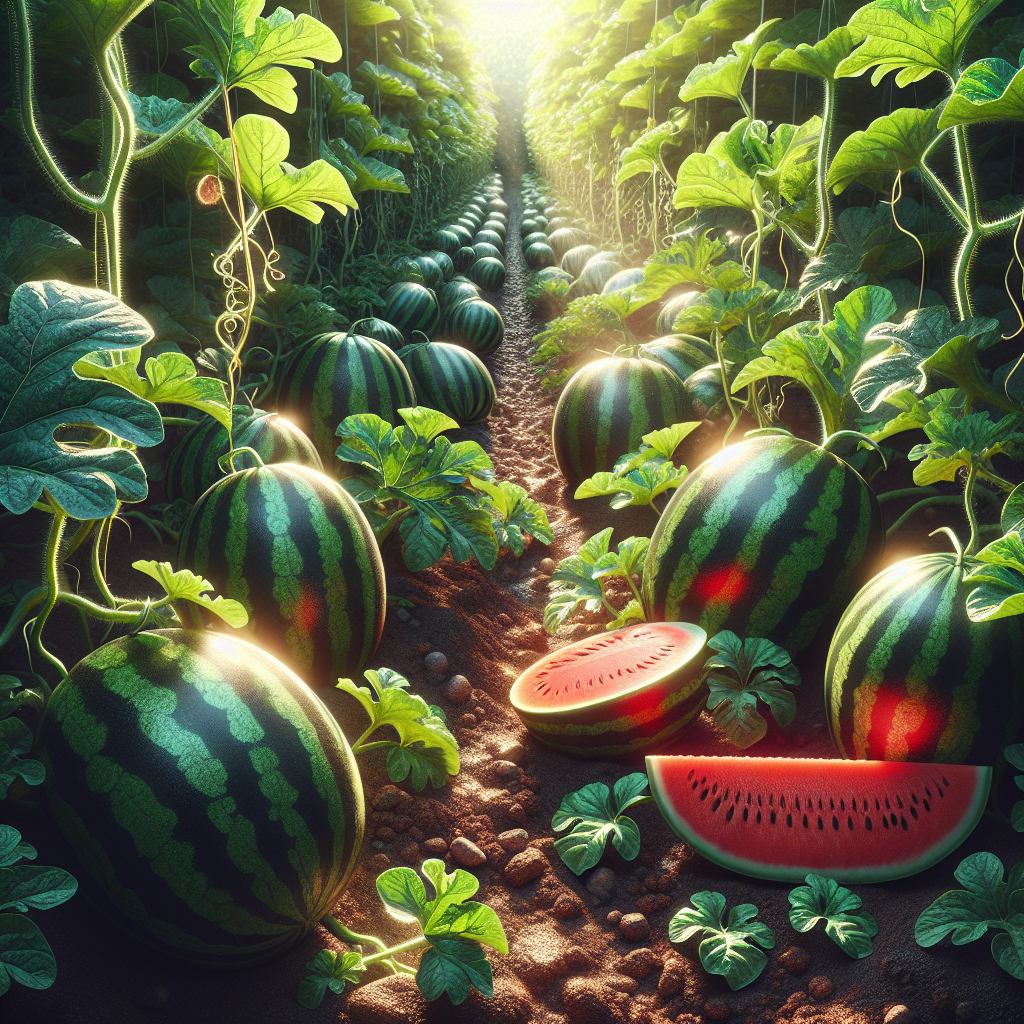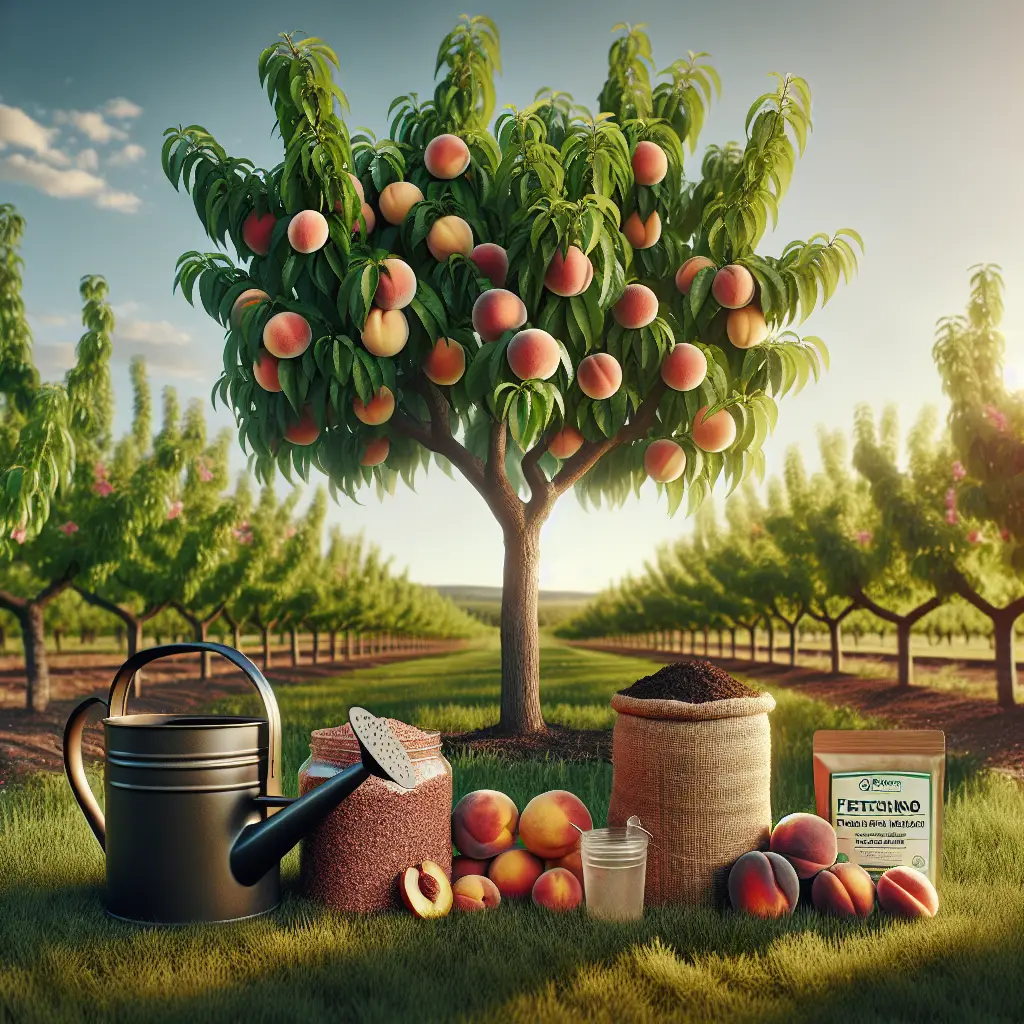Watermelon Growing Secrets for Juicy Harvests
Updated June 6, 2024 at 10:58 pm

Essential Overview for Growing Watermelons
- Pet Friendly: Generally safe, but ensure ripe fruits are out of pets reach as the seeds can be a choking hazard.
- Light Requirements: Full sunlight is ideal for watermelon plants to thrive.
- Watering: Consistent, deep watering is vital, especially during fruit set and growth.
- Humidity: Watermelons can handle some humidity, but too much can encourage fungal diseases.
- Temperature: Prefers warm conditions, with soil temperatures above 70°F for optimal growth.
- Difficulty: Moderate, requires attention to watering, pest control, and space to grow.
Selecting the Best Watermelon Varieties
Choosing the right watermelon variety is crucial for a bountiful harvest. The ‘Sugar Baby’ variety is popular for its sweet, red flesh and relatively small size, making it perfect for gardeners with limited space. Another favorite among growers is the ‘Crimson Sweet’, renowned for its classic watermelon flavor and longer shelf life.
Preparing Your Garden for Watermelon Planting
Preparation begins with soil testing; watermelons favor sandy loam soil with good drainage and a neutral pH. Amend your soil with organic compost or well-aged manure to improve fertility. Raised beds can also provide an excellent environment for watermelon growth by improving drainage and increasing soil temperature.
Mastering Watermelon Planting Techniques
Start seeds indoors in biodegradable peat pots about a month before the last frost date. Once the danger of frost has passed and the soil has warmed, transplant the seedlings into your prepared garden bed, spacing them about 2 feet apart in rows 5 to 6 feet apart. Watermelons need room to roam, so consider using trellises for vertical growth in smaller gardens.
Watering for Sweet and Plump Watermelons
Watermelon plants are thirsty, requiring consistent moisture during germination and early growth. Once established, deep, infrequent watering encourages roots to dive deep into the soil, making plants more drought-tolerant. Always water at the base of the plant to avoid wetting leaves and reducing disease risk.
Feeding Your Watermelons for Optimal Growth
Use a balanced fertilizer to feed your watermelons. As the plants grow and flowers appear, switch to a phosphorus-rich fertilizer to promote blossoming and fruit set. Avoid high nitrogen fertilizers later in the season as they can encourage foliage at the expense of fruit development.
Battling Pests and Diseases Naturally
Cucumber beetles and aphids can be a nuisance. Introduce beneficial insects like ladybugs or apply neem oil as a natural pesticide. To combat fungal diseases like powdery mildew, ensure good air circulation around the plants and apply a fungicide if needed.
Identifying the Perfect Time to Harvest
Look for signs such as a yellowing underside, a drying tendril closest to the fruit, and a hollow sound when tapped. These signs indicate that your watermelon is ready for harvest. Time this right, and you’ll be rewarded with the sweetest, juiciest watermelons right from your garden.
Mulching and Soil Management for Watermelon Plants
Applying a layer of organic mulch helps retain soil moisture, reduce weeds, and maintain a stable soil temperature. Straw, grass clippings, or shredded bark are excellent choices. Be careful not to pile mulch too close to the stems to prevent rot and disease.
Effective soil management includes rotating your watermelon crops with non-cucurbit plants to minimize disease carryover. Moreover, applying beneficial microbes, such as mycorrhizae to your soil, can enhance nutrient uptake and plant resilience.
Recognizing and Solving Common Watermelon Problems
Yellow leaves may indicate overwatering or a nutrient deficiency, typically nitrogen or iron. If leaves are wilting and the weather has been dry, the issue might be under-watering. Adjust watering patterns according to these symptoms and consider a soil test to confirm nutrient levels.
Splitting fruit can occur from inconsistent watering. To prevent this, ensure your watermelon plants receive regular water, gradually decreasing as the fruit matures. A steady water supply helps fruits grow without the stress that leads to cracking.
Pruning for Prime Watermelon Production
While not always necessary, pruning can improve air circulation and sunlight exposure, which can speed up ripening. Remove any dead leaves or non-productive flowers. Limiting the number of fruits per plant to two or three can also ensure the watermelons that do develop are larger and taste better.
Pruning should be done carefully with sterilized tools to prevent the spread of disease. Always make clean cuts, and avoid tearing the plant, which can open it to infection and pests.
Support Systems: Using Trellises and Nets for Vertical Growing
For smaller spaces, trellises, and sturdy support structures enable vertical growing of watermelon vines, saving valuable ground space. Make sure the trellis is robust enough to support the weight of growing fruit.
When fruits begin to grow, support them with slings made from materials like pantyhose or cloth. This will help distribute the fruit’s weight evenly and prevent it from falling off the vine prematurely.
Harvesting Tips and Techniques
Use a sharp knife or shears to cut the watermelon from the vine, keeping a decent amount of stem attached. Handling the watermelon carefully to avoid bruising is also important, as damaged areas can spoil quickly.
After harvesting, watermelons can withstand short periods at room temperature. However, if not consumed immediately, storing them in a cooler environment can help retain freshness.
Post-Harvest Care and Storage
Proper post-harvest care is vital for preserving your watermelon’s flavor and texture. Ideally, store watermelons at 50-60°F with moderate humidity. Avoid placing the fruit in direct contact with the ground to prevent rotting.
For longer storage, you might use ethylene absorbers or keep them in a well-ventilated area away from other ripening fruits to extend shelf life. However, remember that no watermelon variety will maintain peak sweetness indefinitely.
Saving Seeds for the Next Season
Choose the healthiest and most flavorful watermelon for seed saving. Scoop out the seeds, clean and dry them thoroughly before storing them in a cool, dry place. Label the container with the variety and date to keep track of your seeds.
Because watermelons can cross-pollinate, saved seeds might produce fruit different from the parent plant if grown near other varieties. To preserve purity, only save seeds from isolated plants or hand-pollinate flowers.
Community and Resources
Engaging with local gardening communities and resources like county extension offices can provide tailored advice for your area. They might offer workshops, soil testing services, and gardening tips that are invaluable for an aspiring watermelon grower.
Various online forums and social media groups also provide platforms for discussing watermelon growing techniques, sharing experiences, and getting advice from fellow gardeners around the world.
Watermelon Recipes and Preservation Methods
Knowing a few recipes can help you enjoy your watermelon harvest in creative ways. Try making watermelon sorbet, salads, or pickled rinds. You can also juice watermelon for a refreshing drink or freeze cubes for later use.
For preservation, consider making watermelon jam or dehydrating thin slices to make watermelon chips. These methods allow you to savor the fruits of your labor even beyond the growing season.
Watermelon Growing Kits and Tools
If you’re looking to start growing watermelons, consider investing in a watermelon growing kit. These kits typically come with seeds, instructions, and sometimes even soil amendments. One reputable option is the Burpee Watermelon Starter Kit, which has garnered positive reviews for its seed germination rates and comprehensive guidelines.
The kit includes high-quality seeds and a detailed guide to assist beginners. Reviewers have appreciated the clear, step-by-step instructions and the fact that the seeds are non-GMO. Although some users suggested that the inclusion of a small trellis or climbing support would make the kit even better, overall, the feedback has been very favorable.
-
Pros:
- High germination rates
- Clear instructions included
- Non-GMO seeds
-
Cons:
- Lacks support structures for vertical growing
Find This and More on Amazon
Gardening Books and Guides for Further Learning
Regardless of your experience level, it’s always beneficial to learn more about watermelon cultivation from books and guides. “The Watermelon Book” by Jennifer Kroll is an excellent resource, full of growing tips, history, and watermelon facts. Readers have found it informative and engaging with its blend of practical advice and trivia.
According to positive reviews, the book offers a wealth of knowledge in an easy-to-read format. While some may find the historical details less necessary, many readers enjoy the anecdotes that make the guide more than just a gardening manual. It’s said that the sections on companion planting and organic pest control are particularly helpful.
-
Pros:
- Comprehensive cultivation tips
- Entertaining historical insights
- Advice on organic gardening practices
-
Cons:
- Some readers may prefer more focus on practical aspects
Find This and More on Amazon
Implementing Sustainable Practices in Your Watermelon Garden
Sustainable gardening practices, such as collecting rainwater for irrigation and using natural pest deterrents, not only benefit the environment but also contribute to healthier, tastier watermelons. Composting is another excellent way to utilize kitchen and garden waste to enrich your soil organically.
Additionally, using cover crops in the off-season can improve soil structure and fertility. Growing green manure crops such as clover or vetch can be tilled into the soil before planting season, providing a natural, nutrient-rich environment for your watermelons.
Enhancing Flavor through Proper Sunlight and Shade Management
To achieve that perfect sweetness, balancing the amount of sunlight and shade your watermelon plants receive is key. While they thrive in full sun, during the hottest part of the day, young plants may benefit from light shading to prevent scorching.
Using a shading cloth can protect the plants from intense midday heat, while still allowing them to soak up the necessary rays to sweeten the fruit. As plants mature, they become more tolerant to heat and less shading is required.
Protecting Watermelon Flowers for Fruit Set
The flowers of watermelon plants are where the magic begins for fruit development. Protecting these delicate flowers from harsh weather and pests is critical. Male and female flowers appear on the same plant, and bees are essential for pollination.
Encouraging pollinators into your garden by planting flowers or avoiding pesticides can increase your yield. If you notice a lack of bees, you might consider hand pollination by gently transferring pollen from the male flowers to the females with a small brush.
Understanding Watermelon Anatomy for Better Care
Getting familiar with the parts of your watermelon plant can guide you in providing the best care. The main vine should be healthy and vigorous, and secondary vines will stem from it, bearing flowers and fruits.
Leaves should be a vibrant green unless they’re aged, in which case yellowing is normal. The tendrils, curly cues that grasp for support, help indicate the ripeness of fruit when they start to dry out near a maturing melon.
Optimizing Plant Spacing for Disease Prevention
Crowded watermelon plants can lead to increased humidity beneath the foliage, which is an ideal environment for fungal diseases to thrive. By spacing plants adequately, you allow for better air circulation, which in turn helps to reduce disease risk.
Adhering to the spacing recommendation of 2 feet between plants in rows 5 to 6 feet apart, as noted earlier, is essential for healthy, disease-free watermelon vines.
Stress Management for Watermelon Vines
Plants, like people, can get stressed. Watermelon vines are no exception and can react negatively to drought, overwatering, nutrient imbalances, or temperature extremes. Being attentive to the needs of your plants will help prevent stress that can compromise fruit quality.
Regularly inspecting your plants and adjusting care as needed can go a long way in mitigating stress factors. For instance, increasing watering during a heat wave or providing shade can help alleviate drought stress.
Ensuring Pollinator Activity for Fruit Set
Without pollinators, there would be no watermelon harvest. Encouraging bees and other pollinators to your garden is vital. Try planting a wildflower border or setting up a water source for bees.
Should pollinators be scarce in your area, gentle hand pollination can rescue your crop. But remember, the more natural the pollination process, the better the potential for fruit set.
Season Extension Techniques for Early and Late Harvests
To get a jump on the season or extend it, consider using floating row covers or cold frames. These can help protect seedlings from late spring frosts or give you a few extra weeks of growth in the fall.
Be aware, however, that covers must be removed during the day to allow for pollination once flowers appear. Using plastic mulch to warm the soil can also speed up the early season growth of watermelon plants.
Organic Ways to Boost Watermelon Flavor
Many gardeners swear by organic methods for growing sweeter watermelons. Using organic fertilizers like fish emulsion or seaweed extract can provide essential nutrients while maintaining a natural growing environment.
Additionally, applying compost tea can not only help with nutrition but also aid in warding off certain pests and diseases. These organic options enhance soil health and, in turn, can lead to tastier, more flavorful melons.
Creative Gardening Solutions for Space Saving
Innovative techniques like square foot gardening or container growing can help you maximize yield in limited spaces. These methods allow you to grow watermelons even on patios or balconies.
Using containers also gives you the advantage of moving plants to optimize sun exposure or protect them from severe weather. With the right container and support, you can grow healthy vines and fruits even without a traditional garden plot.
Recording Your Watermelon Growing Journey
Keeping a garden journal can be instrumental for future watermelon growing success. Recording planting dates, weather patterns, watering schedules, and any issues that arise during the season provides valuable insights for the next harvest.
Noting what worked well and what didn’t will help you refine your techniques over time, ultimately leading to more robust plants and juicier watermelons year after year.
Encouraging Healthy Soil Ecosystems
A thriving soil ecosystem is the foundation for any successful garden, including watermelon patches. Encouraging beneficial organisms like earthworms or predatory nematodes can naturally enhance soil structure and fertility while keeping harmful pests at bay.
Incorporating organic matter regularly and avoiding chemical soil sterilants are ways to foster a vibrant underground community that supports healthy plant growth.
The Role of Companions: Plant Pairing for Watermelons
Companion planting can be a highly effective strategy for watermelon growers. Certain plants, when grown alongside watermelons, can deter pests, improve soil health, or even enhance flavor.
Marigolds, for example, are known to repel nematodes and other pests, while herbs like dill attract pollinators. Conducting a bit of research or experimenting with different companions can yield surprising and beneficial results.
Schedule and Routine: Key to Growing Success
Maintaining a consistent routine can make all the difference in growing watermelons. Consistent watering, fertilizing, and monitoring will keep your vines thriving and productive.
Setting a schedule not also ensures that your plants receive the care they need but also helps you to monitor their progress and adjust your strategies as needed through the growing season.
Engaging with the Watermelon Growing Community
Finally, don’t underestimate the power of community when it comes to growing watermelons. Whether it’s a local gardening club, an online forum, or even your neighbors, fellow enthusiasts can provide support, advice, and even seeds or cuttings.
Sharing experiences and learning from others enriches your gardening journey and can make the process of growing watermelons more enjoyable and successful.
Reflections on a Season of Watermelon Growing
As you tend to your watermelon patch throughout the season, take time to enjoy the journey. From the first sprout to the last slice of juicy fruit, each step offers a chance to learn and grow as a gardener.
With the tips and advice shared in this guide, your endeavors are sure to bear delicious rewards. Here’s to sweet successes and bountiful harvests in your watermelon garden!
Shop more on Amazon

